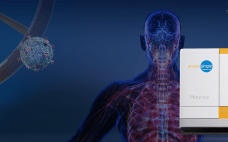This webcast features: Cristina Bernal Martinez, Applications & Support Engineer, and Ann D’Ambruoso, Manager, Product Applications and Marketing, Getinge Single-use systems allow for a faster and easier workflow while simultaneously reducing the risk of errors and contamination in the development process. Nonetheless, fundamental bioreactor principles must be understood to correctly scale up in single-use bioreactors. Learn about the design factors in Applikon’s single-use bioreactors and review common scale-up strategies based on tip speed, power input, and kLa. Furthermore, shear stress…
Sponsored Content
Using Bio-Layer Interferometry for A Fast and High Precision Influenza Vaccine Potency Assay
A fast and accurate determination of vaccine titer during manufacturing is important in understanding vaccine development process performance, and for correctly scaling each process step. The Single Radial Immunodiffusion (SRID) technique has been the most commonly used technique for vaccine titer determination. However, SRID is time consuming and generally exhibits poor precision. An alternative assay that can speed up the analysis process and provide accurate and precise potency data on different vaccine strains is therefore desirable. The Octet® platform’s Bio-Layer…
Assessing Your AAV Capsid Content for Product Quality? Get the Confidence You Need with an Automated CE Platform
Looking for a hassle-free and rapid analytical method to detect full, partially filled, and empty Adeno-associated virus (AAV) capsids for your gene therapy development? Viral capsid content can impact gene therapy product efficacy and is therefore considered a Critical Quality Attribute (CQA) that must be properly evaluated during the development and manufacturing of AAVs. Traditional analytical tools such as transmission electron microscopy (TEM), analytical ultracentrifugation (AUC), and ion-exchange chromatography (IEX) can be used to characterize capsid content but are complex…
Manufacturing Capacity and Supply Chain Resilience
This webcast features: Ari Ojinaka, Production Manager, Astrea Bioseparations With increasing demand for vaccines and advanced therapeutic treatments, innovation and resilience are critical to stay ahead of the quickly shifting needs of the industry. As demand for bioseparation products continues to increase and evolve to accommodate traditional and advanced drug profiles, suppliers must ensure that they are delivering more than just products to customers. It is essential to evaluate effective ways to manage and increase capacity and supply chain resilience…
Cell Line Development: Accelerating Process Optimization by Combining Ambr® 15 Cell Culture with Octet® Titer Measurements
Cell line development (CLD) involves the screening of thousands of clones to find those that are stable, produce high yields of the bioproduct and exhibit desired critical quality attributes (CQAs). Typically screening and process optimization activities will be carried out at the small scale in bioreactor cultures to ensure that results translate up to larger bioreactor scales. Performance data is primarily based on cell growth, cell viability, metabolite analysis and product titer, and assessed over the entire culture process duration.…
Recombinant Proteins for Cell and Gene Therapy Research: A Conversation with Shenandoah Biotechnology
Recombinant proteins such as growth factors and cytokines are essential for cell therapy, gene therapy and regenerative medicine research, development and manufacturing. These proteins are critical in the production of desired cell types and subsequent differentiation of cells, to deliver the desired effect. Founded 15 years ago, Shenandoah Biotechnology applies a proprietary method of folding and purifying recombinant proteins from both bacterial and mammalian systems to enable cost-effective, large-scale production of Cell Therapy Grade proteins to support these groundbreaking treatments.…
Enhancement of Tablet Coating Using an Innovative Functional Excipient
During formulation of solid dosage forms, film coating is used to improve the appearance and stability of tablets, make them easier to swallow, mask the taste, modify or sustain release, protect the drug from the harsh gastric environment, protect from moisture and/or oxidation and, as a result, to improve the stability and overall therapeutic effect of the final drug product. Depending on the individual needs, a polymer with appropriate properties is chosen during formulation development to serve as film-coating matrix.…
Cytiva Strategy for Host Cell Protein Control
A critical aspect of therapeutic development and manufacture is host cell protein (HCP) detection, quantitation, and removal from drug substances, to ensure efficacy and prevent immunogenicity. It is important to mitigate risk by challenging your assay for each new molecule and selecting the most suitable kit. Cytiva offers a range of solutions to support scientists and developers in creating an effective strategy for HCP control. Read more about our strategy for HCP control.
A Scalable Platform for GMP and High-Quality Plasmid Manufacturing
This webcast features: Dr. Mack Kuo, Associate Director BioProcess Development, Wacker Biotech US Inc. Demand for high-quality good manufacturing practice (GMP) plasmid DNA has grown significantly in the past few years. The recent proliferation of mRNA manufacturing, DNA vaccines, viral vector production, CAR T-cell therapies, and CRISPR gene editing technologies have all contributed to a bottleneck in availability of plasmid manufacturing capability. With decades of collective plasmid DNA manufacturing experience, the staff at Wacker Biotech US have released over 100…
TESSA Technology: A Plasmid-Free, Scalable System to Transform AAV Manufacture
This webcast features: Dr. Weiheng Su, Principal Scientist, OXGENE Adenoassociated virus (AAV) is a popular choice of viral vector for new gene therapies, but manufacturing systems have not kept pace with biological advances, leaving these therapies costly, difficult to produce at scale, and subject to inherent batch-to-batch variability. In this webinar, Dr. Weiheng Su describes how rethinking AAV manufacture “from the ground up” allowed OXGENE to manipulate AAV’s natural relationship with adenovirus to address these challenges with their novel tetracycline-enabled…










